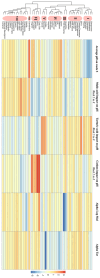Characterization of varietal effects on the acidity and pH of grape berries for selection of varieties better adapted to climate change
- PMID: 39450078
- PMCID: PMC11499634
- DOI: 10.3389/fpls.2024.1439114
Characterization of varietal effects on the acidity and pH of grape berries for selection of varieties better adapted to climate change
Abstract
Climate change is drastically modifying berry composition and wine quality across the world. Most wine regions with a history of winemaking are suffering from a loss of typicity and terroir expression because of climate change impact on berry components at harvest, including wine acidity, with total acidity decreasing and pH increasing. Such changes can have a major impact on wine stability and quality. One important option for adaptation is the selection of grapevine varieties better adapted to warmer and drier conditions. Weekly measurement of tartaric acid, malic acid, pH and titratable acidity from veraison until maturity were carried out on 51 varieties over seven years in two experimental plots. Varietal differences were shown for the rate of malic acid degradation during the ripening period, with some varieties metabolizing malic acid faster per unit of thermal time than others. Some varietal differences were also noticed regarding tartaric acid modulation, which can occur under exceptionally high temperatures. Differences in the dynamics of pH evolution in grape must over the growing season were evaluated and varieties characterized with regard to organic acids (tartaric acid and malic acid), inorganic compounds (cations) as well as pH levels and stability. This multi-trait approach allows the selection of grapevine varieties based on parameters linked to their acidity, which is of particular importance in the context of climate change.
Keywords: Vitis Vinifera; climate change; grapevine; inorganic cations; malic acid; pH; tartaric acid; varietal traits.
Copyright © 2024 Plantevin, Merpault, Lecourt, Destrac-Irvine, Dijsktra and van Leeuwen.
Conflict of interest statement
Authors MP and LD were employed by company Château La Tour Carnet. JL was employed by company Bernard Magrez Grands Vignobles. The remaining authors declare that the research was conducted in the absence of any commercial or financial relationships that could be construed as a potential conflict of interest.
Figures






References
-
- Adelsheim D., Busch C., Catena L., Champy B., Coetzee J., Coia L., et al. . (2016). Climate change: Field reports from leading winemakers. J. Wine Economics 11 (1), 5–47. doi: 10.1017/jwe.2016.4 - DOI
-
- Batista L., Monteiro S., Loureiro V. B., Teixeira A. R., Ferreira R. B. (2010). Protein haze formation in wines revisited. The stabilising effect of organic acids. Food Chem. 122, 1067–1075. doi: 10.1016/j.foodchem.2010.03.076 - DOI
-
- Bigard A., Romieu C., Sire Y., Veyret M., Ojéda H., Torregrosa L. (2019). The kinetics of grape ripening revisited through berry density sorting. OENO One 53. doi: 10.20870/oeno-one.2019.53.4.2224 - DOI
LinkOut - more resources
Full Text Sources

